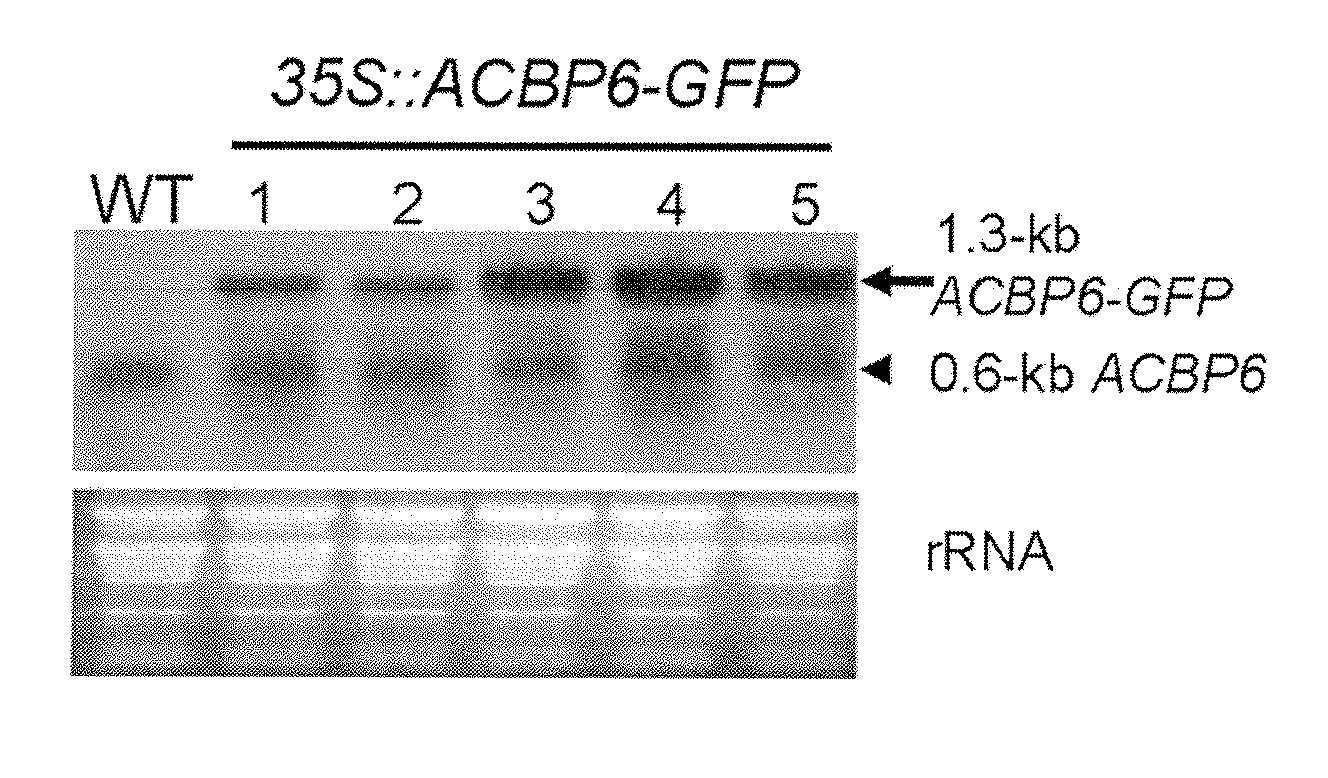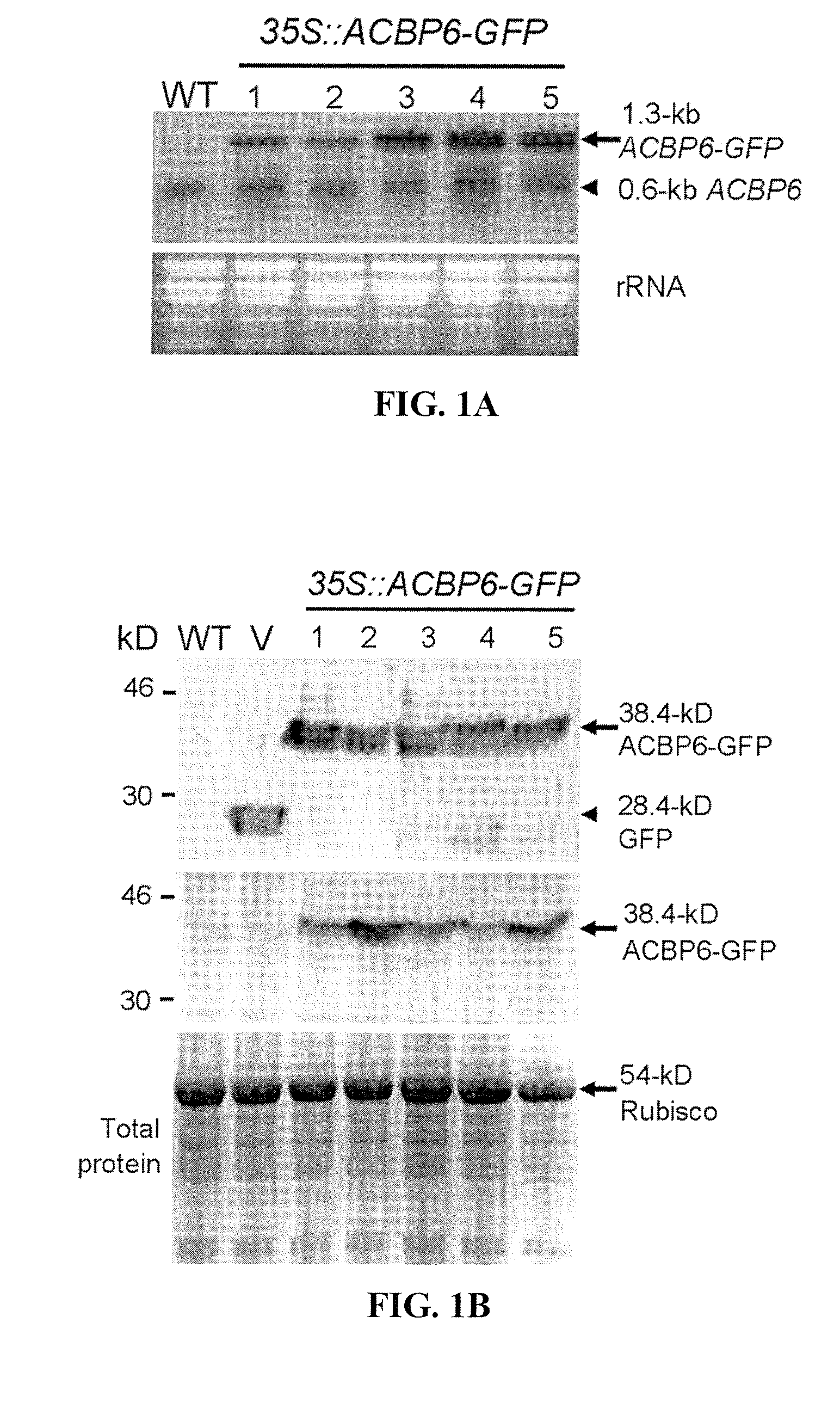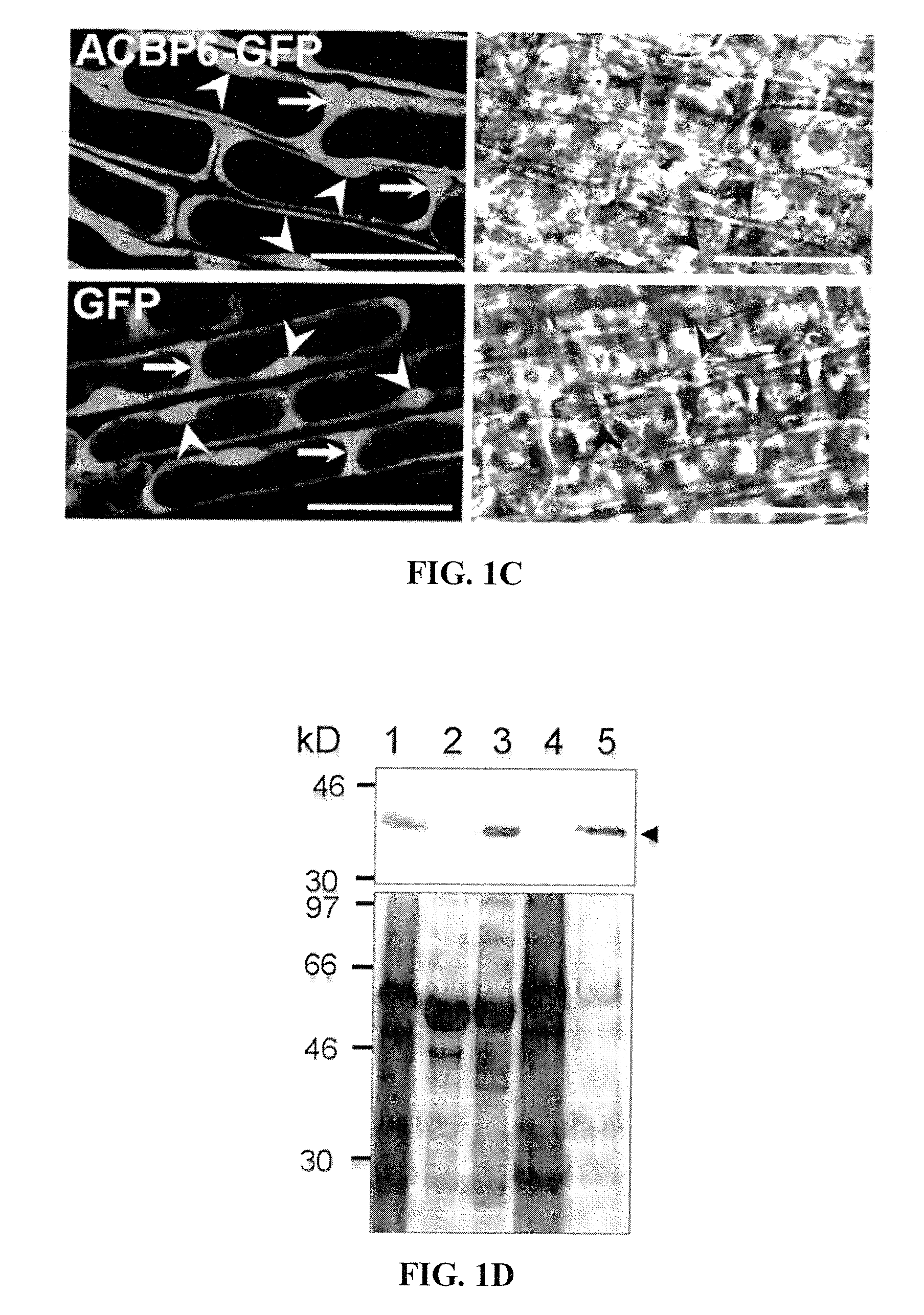Methods using acyl-coa binding proteins to enhance low-temperature tolerance in genetically modified plants
- Summary
- Abstract
- Description
- Claims
- Application Information
AI Technical Summary
Benefits of technology
Problems solved by technology
Method used
Image
Examples
example 1
ACBP6 is a Cytosolic Protein
[0089]ACBP6 was predicted to be localized to the cytosol by PSORT analysis (http: / / psort.nibb.ac.jp). A 35S::ACBP6-GFP construct was generated by fusing the ACBP6 coding region to the autofluorescent protein tag, eGFP in vector pBI-eGFP (Shi et al., 2005) for expression from the Cauliflower Mosaic Virus (CaMV) 35S promoter. Transgenic Arabidopsis lines expressing 35S::ACBP6-GFP (SEQ. ID No: 6) were obtained using Agrobacterium-mediated transformation. Expression of the 1.3-kb ACBP6-GFP mRNA in 5 independent 35S::ACBP6-GFP transformants was detected in northern blot analysis using an ACBP6 cDNA probe which also hybridized to the endogenous 0.6-kb ACBP6 mRNA (FIG. 1A). The expression of the 38.4-kD ACBP6-GFP (SEQ. ID No: 7, consisting of 10.4-kD ACBP6 fused to 28-kD GFP) in these five lines was confirmed in western blot analyses using anti-GFP and anti-ACBP6 antibodies (FIG. 1B). Subsequently when premature root cells of 2-week-old T2 transgenic Arabidopsis...
example 2
ACBP6 mRNA and Protein are Induced by Cold Treatment
[0091]The spatial pattern of ACBP6 expression was investigated by northern blot analyses using total RNAs extracted from various organs. Northern blot analysis was also used to analyze the response of ACBP6 expression to various forms of biotic and abiotic stresses. ACBP6 mRNA was more highly expressed in leaves and stalks compared to roots, flowers and siliques (FIG. 2A). A similar pattern in distribution of ACBP6 protein was observed in western blot analysis using ACBP6-specific antibodies (FIG. 2B). ACBP6 mRNA was cold-induced (FIG. 2C) but was not induced by treatments using fungal elicitor (arachidonic acid), high salt and methyl jasmonate in whole plants (data not shown). Absence of induction with high salt and methyl jasmonate treatments in northern blot analysis is consistent with data (www.weigelworld.org / resources / microarray) from microarray analysis on ACBP6 (At1g31812) expression. Northern blot analysis using total RNA ...
example 3
Characterization of an acbp6 Knockout Mutant
[0092]An acbp6 T-DNA knockout mutant (SALK—104339) was obtained from the Arabidopsis Information Resource (TAIR) to further investigate the function of ACBP6 upon cold treatment. The mutant was subsequently characterized. The T-DNA insert in ACBP6 in the acbp6 homozygous mutant was confirmed by the Polymerase Chain Reaction (PCR) using gene-specific primers (ML770 and ML771) and a T-DNA border primer, LBa1 (FIG. 3A). On PCR analysis using ML770 / ML771 (FIG. 3B, top panel), a 0.9-kb band was amplified from wild-type Arabidopsis (lanes 2 and 5) and the acbp6 heterozygous mutants (lane 1) but not homozygous mutants (lanes 3 and 4). When LBa1 / ML771 primers were used in PCR (FIG. 3B, bottom panel), a 0.5-kb band was observed in the acbp6 heterozygous (lane 1) and homozygous mutants (lanes 3 and 4) but not in wild type (lanes 2 and 5).
[0093]Results from DNA sequence analysis of the PCR products spanning the junctions between ACBP6 and the T-DNA s...
PUM
| Property | Measurement | Unit |
|---|---|---|
| Freezing point | aaaaa | aaaaa |
| Temperature | aaaaa | aaaaa |
| Freezing point | aaaaa | aaaaa |
Abstract
Description
Claims
Application Information
 Login to View More
Login to View More - R&D
- Intellectual Property
- Life Sciences
- Materials
- Tech Scout
- Unparalleled Data Quality
- Higher Quality Content
- 60% Fewer Hallucinations
Browse by: Latest US Patents, China's latest patents, Technical Efficacy Thesaurus, Application Domain, Technology Topic, Popular Technical Reports.
© 2025 PatSnap. All rights reserved.Legal|Privacy policy|Modern Slavery Act Transparency Statement|Sitemap|About US| Contact US: help@patsnap.com



